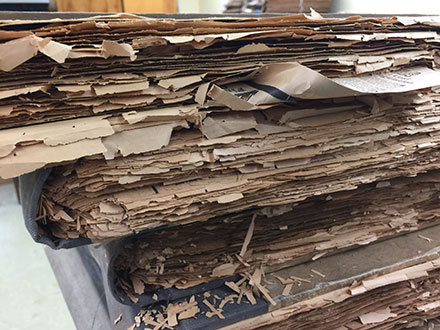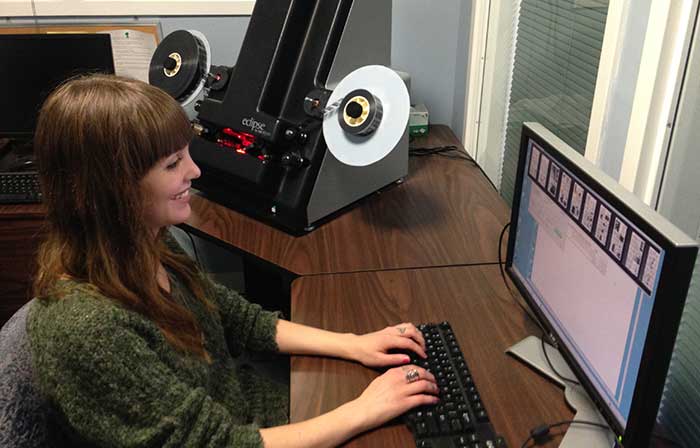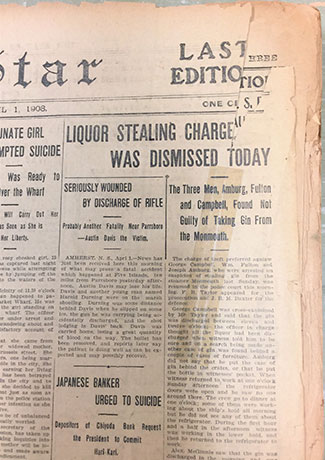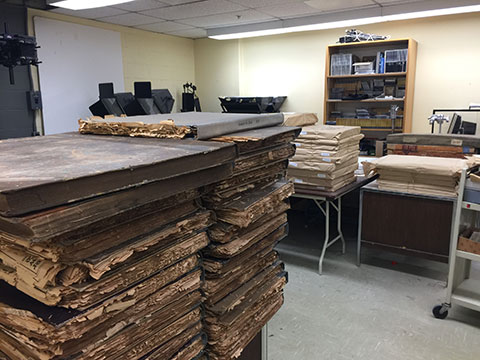Initial Print Preservation Project

Time is of the essence.
The initial phase of digitization and “ingestion” of print material was completed over two years, 2012 and 2013, as a collaboration between the Centre for Digital Scholarship (then called the Electronic Text Centre) and the Microforms Department (now part of Archives & Special Collections) in an effort to inventory and digitally preserve deteriorating collections. During this time period, dedicated student assistants were hired, as well as pulling in all students working in UNB Libraries to contribute to the preparation work for the project.
Detailed information was recorded on the issues of newspapers digitized, including numeration (or lack of issue and volume numbers), page count, size of pages, title changes, possible missing issues, publishers, editors, condition for each calendar year of the titles. This was to ensure any issues on the hard copy were recorded to demonstrate the digital copy was as high quality as possible. As well, newspapers were conserved to enable the production of the best quality image possible.
Intensive, background research was required to determine what newspapers met the criteria to be digitized, historical publication information, where additional issues could be located to fill in runs, and generally amassed data on the titles found in the hard copy newspaper collection. Other organizations kindly lent issues of papers to fill in runs, including the New Brunswick Aboriginal Peoples Council and Legislative Library of New Brunswick (Mal-a-Mic), NB Military Heritage Museum on Base Gagetown (Post Gazette), Moncton Public Library (Riverview This Week), UPEI Archives (Gigmanag), and Doaktown Public Library (Miramichi Headwaters).
Two Indigenous papers were specifically targeted for digitization: Mal-A-Mic and Gigmanag (Prince Edward Island). The Quoddy Tides (published in Eastport, Maine) was also digitized because of the community’s close link with New Brunswick.

Digitization began in the basement of the Harriet Irving Library in 2011, employing only a few student assistants on a part-time basis using an Atiz Bookdrive Pro. In 2012, a second Atiz station was acquired and both were soon moved to a new imaging lab on the 5th floor of the HIL. The full efforts persisted for two years, and the bulk of the scanning for this phase of the project was completed by the end of 2014.
Microfilm Scanning
Early in 2014, UNB Libraries was contracted to digitize from microfilm more than a century's worth of three of New Brunswick's major daily newspapers: The Daily Gleaner, The Telegraph Journal, and the Moncton Times & Transcript. This project, totalling nearly 3 million images, intensified production demands tremendously, as we ramped up our workflow capacity, quality control and automatiation processes. Several new staff were hired. This partnership further extended UNB Libraries' ongoing digitization capability with the acquisition of a nextScan Eclipse microfilm scanner, stroage and processing servers.
Digital access to the archive was made available to Brunswick News subscribers, and as part of the contract onsite access was provided at the University of New Brunswick, Saint John Free Public Library, and the Provincial Archives of New Brunswick.

New Platform New Name
In 2019 after considerable development, a completely new version of “Newspapers @ UNB Libraries” was launched by UNB Libraries. The platform, built in-house by UNB Libraries Systems Group on Drupal, includes the digital issues of New Brunswick Historical Newspapers (the original preservation project), a comprehensive listing of microformat newspapers held at UNB Libraries, and current, hard copy newspaper titles.
In Ocober 2022, following 2021 partnership with the Provincial Archives of New Brunswick and the Council of Archives New Brunswick, the site was rebranded to reflect the scope, scale and ambitions of the project as the New Brunswick Historical Newspapers Project (NBHNP).
In April 2022, the PANB New Brunswick Newspaper Directory was imported and merged with existing records in NBHNP. Holdings now extend to many provincial institutions having significant print or microfilm content, as well as Library and Archives Canada and the Library of Congress.
Ongoing Digitization Work and Data Collection
The New Brunswick Historical Newspaper Project site is now the most accurate index for newspapers published in the province, with hundreds of new titles as well as background information added from the last iteration of the PANB New Brunswick Newspaper Directory. Information on titles and institutional holdings will be updated on the site as it is obtained. On each title page, updated information can be contributed by using the “Report additional information or errors” button.
Digitization and preservation work is ongoing, specifically targeting material that is rare and/ or is of a material condition that is high risk for deterioration. Indexing information on the New Brunswick Historical Newspapers Project site is key in determining which titles to target for digitization.
To date, well over 3 million pages of historical newsprint have been digitized by UNB Libraries through the efforts of staff (including the many student assistants) from the Centre for Digital Scholarship, Microforms, and Library Systems, as well as partners at the Provincial Archives of New Brunswick. Collaborations with the greater New Brunswick library and archives community will help ensure that this unique digital collection continues to grow and expand for years to come.
